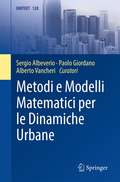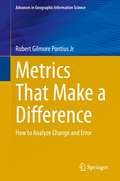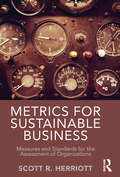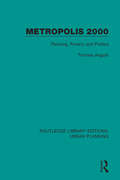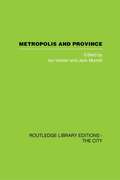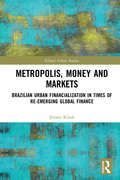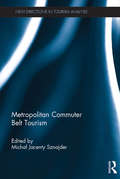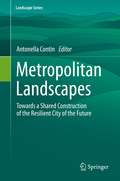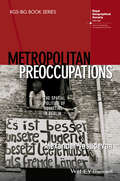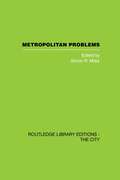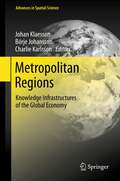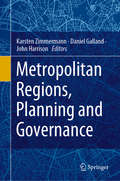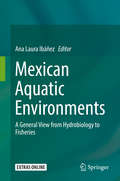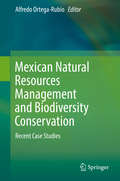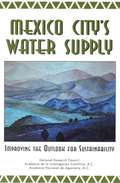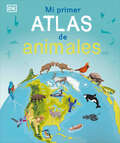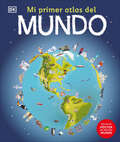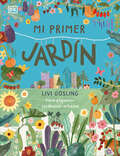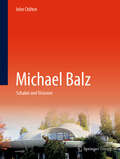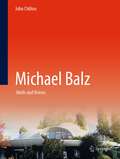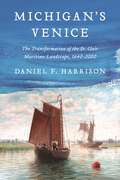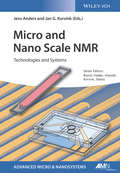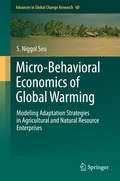- Table View
- List View
Methylmercury Accumulation in Rice: Process and Regulation (Emergent Environmental Pollution)
by Xinbin Feng Jörg Rinklebe Jianxu WangThis book presents state-of-the-art knowledge related to concerns about methylmercury (MeHg) in the soil-rice system. It covers increasing concerns about human exposure to methylmercury through the consumption of Hg-contaminated rice and shows the global contamination of soil and how Hg can be mobilized, immobilized, methylated, and demethylated in soils. The authors present the biogeochemical process through which rice plants accumulate Hg. This book comprehensively displays the biogeochemical behavior of Hg in paddy soils and rice plants, as well as the current remediation technologies to mitigate Hg risks from paddy soil ecosystems.Features: Provides cutting-edge knowledge on mercury in paddy field ecosystems Discusses the key biogeochemical transformation processes of mercury in soil Explains the accumulation processes of mercury in rice plants Includes case studies on how to inhibit mercury accumulation in rice plants Shows the application of Hg stable isotope traces in paddy soil-rice field studies Intended for researchers, graduate students, and professionals working in fields such as Geochemistry, Agronomy, and Environmental Science and Engineering, this book will be an important resource for anyone interested in Hg contamination in soils and rice and the related risk for human and environmental health.
Metodi e Modelli Matematici per le Dinamiche Urbane (UNITEXT #128)
by Paolo Giordano Sergio Albeverio Alberto VancheriIl testo presenta metodi e modelli per lo studio delle città viste come sistemi evolutivi che interagiscono con il territorio circostante. Gli aspetti morfologici, strutturali e dinamici sono sottolineati e analizzati con metodi qualitativi e quantitativi originati dalla matematica e dalla fisica, ma anche ispirati da altre scienze naturali e dallo studio dei sistemi socio-economici. Il libro usa la matematica in vari modi: i concetti e i metodi che vanno oltre quelli della matematica elementare vengono introdotti ed esposti brevemente, con particolare attenzione a quelli attinenti a probabilità e statistica che, non facendo parte dell'educazione di base, vengono presentati sistematicamente tramite capitoli appositi. Contributi più specializzati includono argomenti come la dinamica urbana, l'analisi di progetti architettonici per il territorio, l'uso di automi cellulari stocastici, la sintassi dello spazio urbano, l'influenza del paesaggio e della geografia, e i modelli per la mobilità urbana. Il libro è rivolto agli studenti di corsi avanzati di architettura, urbanistica e ingegneria, e a tutte le persone che studiano il territorio o vi operano.
Metrics That Make a Difference: How to Analyze Change and Error (Advances in Geographic Information Science)
by Robert Gilmore Pontius JrYour government warns that 10% of your neighbors have a deadly contagious virus. The producer of a diagnostic test advertises that 90% of its tests are correct for any population. The test indicates that you have the virus. This book’s author claims your test has a 50% chance of being false, given your test’s result. Who do you believe? This book gives you insights necessary to interpret metrics that make a difference in life’s decisions.This book gives methods and software that are essential to analyze change and error. Change describes a phenomenon across time points. Error compares diagnoses with the truth. Other texts give insufficient attention to these topics. This book’s novel ideas dispel popular misconceptions and replace previous methods. The author uses carefully designed graphics and high school mathematics to communicate easily with college students and advanced scientists. Applications include but are not limited to Remote Sensing, Land Change Science, and Geographic Information Science.“A wide range of tools to aid understanding of land cover and its change has been used but scientific progress has sometimes been limited through misuse and misunderstanding. Professor Pontius seeks to rectify this situation by providing a book to accompany the researcher’s toolbox. Metrics That Make a Difference addresses basic issues of relevance to a broad community in a mathematically friendly way and should greatly enhance the ability to elicit correct information. I wish this book existed while I was a grad student.” – Giles Foody, Professor of Geographical Information Science, The University of Nottingham“Metrics That Make a Difference provides a comprehensive synthesis of over two decades of work during which Dr. Pontius researched, developed, and applied these metrics. The book meticulously and successfully guides the reader through the conceptual basis, computations, and proper interpretation of the many metrics derived for different types of variables. The book is not just a mathematical treatise but includes practical guidance to good data analysis and good science. Data scientists from many fields of endeavor will benefit substantially from Dr. Pontius’ articulate review of traditionally used metrics and his presentation of the innovative and novel metrics he has developed. While reading this book, I had multiple ‘aha’ moments about metrics that I shouldn't be using and metrics that I should be using instead.” – Stephen Stehman, Distinguished Teaching Professor, State University of New York
Metrics for Sustainable Business: Measures and Standards for the Assessment of Organizations
by Scott R. HerriottMetrics for Sustainable Business is the first book to give students a comprehensive understanding of sustainability in organizations from an accounting perspective. The book walks student through the steps for doing a sustainability assessment, and aims to develop them into financial analysts who understand sustainability reports, and are able to create or audit them. While most books focus on environmental issues, Herriott trains his gaze on the corporate and institutional perspective, covering measurement systems, how to evaluate and improve a standard, and conducting a life cycle assessment. Walking students through the programs of disclosure, the varying standards for corporate ratings, and organizational certification, allows them to grasp the tools for conducting a sustainability assessment and auditing reports. Chapters on accounting for greenhouse gas emissions, water use, and waste introduce students to the technical details in sustainability accounting, while a chapter on the philosophies of sustainability offers an answer to the question, "Why are they asking us to report that?" Richly demonstrated with practical examples and informative visuals, this book will serve students of sustainability, accounting, and integrated reporting.
Metropolis 2000: Planning, Poverty and Politics (Routledge Library Editions: Urban Planning #2)
by Thomas AngottiOriginally published in 1993, Metropolis 2000 analyses 20th century metropolitan development and planning under the economic and environmental conditions of the world’s regions. Attempts to achieve the physical integration of the city without economic equality have failed. The book advances the principle of ‘integrated diversity’ which emphasises linking neighbourhood planning with a broader vision of the planned metropolis and applies a political economy approach, and argues for a new form of pro-urban thinking. The book argues that the basis for a humane approach to city planning is viewing the metropolis as a beneficial accompaniment to national independence, equality and social progress.
Metropolis and Province: Science in British Culture, 1780 - 1850
by Ian Inkster Jack MorrellThis collection of case studies, focusing on British scientific culture during the first industrial revolution, explores the social basis of science in the period and asks why such an extraordinarily rich variety of cultural-scientific experience should have flourished at the time. The book analyses science and scientific culture in their local contexts, both metropolitan and provincial, examining where possibel the relations between the two, and emphasizing the range of scientific associations in London, to individual savants in the provinces. This book was first published in 1983.
Metropolis, Money and Markets: Brazilian Urban Financialization in Times of Re-emerging Global Finance (Global Urban Studies)
by Jeroen KlinkThis book explores the impact of finance on urban spaces as well as cities' role in the social constitution and dissemination of financial logistics and techniques. It brings together literature from different disciplinary areas to increase our understanding of financialization. It observes how non-financial members of society, such as public bureaucrats, urban planners, the media and so on, are actively involved in the financialization of urban areas. With an explicit focus on Brazil, a developing country in the Global South, the book demonstrates how the country has been grappling with complex and contradictory processes of neoliberalization, decentralization, re-democratization and institutional-legal strengthening of frameworks for urban and regional planning, stressing the relations between urban space and finance capital. With a distinct view of filling a gap in the current literature on urban financialization, the book aims to focus on less developed areas in this field and link them with the literature on social studies of finance. This makes the text relevant for academics and scholars of urban studies and planning theory, geography, development studies and political economy, as well as scholars in the US and Europe interested in understanding Brazilian patterns of financialization.
Metropolitan Commuter Belt Tourism (New Directions in Tourism Analysis)
by Michał Jacenty SznajderWith the current rise of metropolitan regions as a present location and driver of the development of rural tourism, agritourism, food tourism and nature tourism, there is a need to analyse the major economic, social, political and managerial aspects of these types of tourism which occur within the rural-urban fringe. This book establishes a current inventory and appropriate future selection of commuter belt tourism products for metropolitan areas. It also explains how public and private resources can be combined to achieve synergistic effects in tourism promotion and provides a structural analysis for the proper management of tourist organisations in metropolitan areas. Additionally, there is insight into how the development of metropolitan areas affects rural tourism and agritourism within broader social, economic and environmental relations. The issue of the growth of metropolitan areas, which is a complex and multifaceted challenge, is elaborated on with diverse examples in Poland and further afield. This is valuable reading for students, researchers and academics of tourism, as well as rural and urban studies, business management, farm management, and leisure studies.
Metropolitan Landscapes: Towards a Shared Construction of the Resilient City of the Future (Landscape Series #28)
by Antonella ContinThis edited volume covers many aspects of the Metropolitan Landscapes. Solutions are needed to meet the demand of the citizens of a renewed metropolitan region landscape. It opens up discussions about possible toolkits for strategic actions based on understanding the territory from geographical, urban, architectural, economic, environmental, and public policy perspectives. This book intends to promote the Metropolitan dwelling quality, ensuring human well-being proposing a discussion on the resilient articulation of the interface space among the city's infrastructure, agriculture, and nature.This book results from the Symposium: Metropolitan Landscapes that MSLab of the Politecnico di Milano and ETSA (Sevilla) organized at the IALE 2019 Conference (Milan, July 2019) to manage radical territory transformation with a strategic vision. The widespread growth of urban areas indicates the importance of building resilient sustainable cities capable of minimizing climate-change impact production.The Symposium aimed to discuss the Urban Metabolism approach considering the combination of Landscapes set in a single Metropolitan Ecosystem. Accordingly, new design strategies of transformation, replacement or maintenance can compose Urban-Rural Linkage patterns and a decalage of different landscape contexts. Ecological interest in environmental sustainability, compatibility, and resilience is not tied exclusively to the balance between production and energy consumption. Thus, it is the integration over time and at several scales of the urban and rural landscapes and their inhabitants that nourish the Metropolitan Bioregion.Moreover, the Metropolitan Landscape Book's research hypothesis is the need for a Glossary, strengthening the basis of understanding Metropolitan Landscape's complexity.This book's topic is particularly relevant to Landscape Urbanism, Architecture, Urban disciplines Scholars, Students and Practitioners who want to be connected in a significant way with Metropolitan Discipline’s research field.
Metropolitan Preoccupations: The Spatial Politics of Squatting in Berlin (RGS-IBG Book Series)
by Alexander VasudevanIn this, the first book-length study of the cultural and political geography of squatting in Berlin, Alexander Vasudevan links the everyday practices of squatters in the city to wider and enduring questions about the relationship between space, culture, and protest. Focuses on the everyday and makeshift practices of squatters in their attempt to exist beyond dominant power relations and redefine what it means to live in the city Offers a fresh critical perspective that builds on recent debates about the “right to the city” and the role of grassroots activism in the making of alternative urbanisms Examines the implications of urban squatting for how we think, research and inhabit the city as a site of radical social transformation Challenges existing scholarship on the New Left in Germany by developing a critical geographical reading of the anti-authoritarian revolt and the complex geographies of connection and solidarity that emerged in its wake Draws on extensive field work conducted in Berlin and elsewhere in Germany
Metropolitan Problems
by S. MilesMetropolitan Problems is the end-product of one of the most dynamic research programmes of its kind ever conceived and executed. The book, which took three years to complete, represents the culmination of a two year study that was highlighted by a conference held in toronto in 1967. In the early 1960s, the bureau of Municipal Research (in metropolitan Toronto) decided that a significant way for it to celebrate Canada's centennial would be to initiate a systematic international study of the world's metropolitan areas. The study, with the official cooperation of the United Nations, was designed to produce positive insights into the methods of coping with the interlocking sets of problems associated with the expansion of the modern metropolis. Twelve papers on various aspects of metropolitan problems were commissioned from an international body of experts. Working with these experts were study groups drawn from forty major metropolitan centres throughout the world. After making exhaustive studies of their respective urban centres, the groups reported their findings and submitted detailed briefs through their representatives at the conference. Throughout the symposium, a conscious effort was made to examine single aspects of social, economic and physical change within the overall perspective of the metropolis. The book reflects this approach. Each chapter directs attention to specific problems of the metropolis, problems resulting from the contradiction between accelerating technology and our ability to cope with the incredible pace and rate of change. Together they prove that, despite differences in technology, culture, and political and social matters, the major urban areas of the world do have much in common. Emerging tendencies can be analysed and corrective and preventative measures be made through comparative analysis. This book was first published in 1970.
Metropolitan Regions
by Charlie Karlsson Johan Klaesson Börje JohanssonMetropolitan growth has been dramatic in the past several decades, and today metropolitan regions are recognized as the main driving forces in national growth and development as well as in national and global innovation processes. The purpose of this book is to contribute to a better understanding of how metropolitan regions and their subsystems interact and compete, why they differ in their capacity to nurture innovation and growth, and how metropolitan policies must be designed to secure the region's long-term vitality. To that end, it presents new contributions on theories of urban growth, institutions and policies of urban change, and case studies of urban growth prepared by international experts.
Metropolitan Regions, Planning and Governance
by John Harrison Karsten Zimmermann Daniel GallandThe aim of this book is to investigate contemporary processes of metropolitan change and approaches to planning and governing metropolitan regions. To do so, it focuses on four central tenets of metropolitan change in terms of planning and governance: institutional approaches, policy mobilities, spatial imaginaries, and planning styles. The book’s main contribution lies in providing readers with a new conceptual and analytical framework for researching contemporary dynamics in metropolitan regions. It will chiefly benefit researchers and students in planning, urban studies, policy and governance studies, especially those interested in metropolitan regions.The relentless pace of urban change in globalization poses fundamental questions about how to best plan and govern 21st-century metropolitan regions. The problem for metropolitan regions—especially for those with policy and decision-making responsibilities—is a growing recognition that these spaces are typically reliant on inadequate urban-economic infrastructure and fragmented planning and governance arrangements. Moreover, as the demand for more ‘appropriate’—i.e., more flexible, networked and smart—forms of planning and governance increases, new expressions of territorial cooperation and conflict are emerging around issues and agendas of (de-)growth, infrastructure expansion, and the collective provision of services.
Mexican Aquatic Environments: A General View from Hydrobiology to Fisheries
by Ana Laura IbáñezPursuing a multidisciplinary approach, this book highlights current challenges in, and potential solutions to, environmental water management in Mexico. It includes an essential review of current literature and state of the art research, providing a one-stop resource for researchers, graduate students and environmental water managers alike. The result of a cooperation between 35 researchers from seven Mexican academic institutions, two Federal Commissions and one international organization, the book links science to practice for living organisms and their environment, while also addressing anthropogenic effects on our water ecosystems. Particularly the book addresses the following subjects: Biodiversity in inland waters, physical and chemical characterization of inland waters, physico-chemical characterization of Mexican coastal lagoons, microbiota in brackish ecosystems, diversity associated with southern Mexico’s pacific coral reefs, fry fish stockings in aquatic epicontinental systems, a review of tuna fisheries in Mexico, fishery resource management challenges stemming from climate change, aquatic invasive alien species, harmful algal blooms, and aquatic protected areas, related ecological and social problems and the importance for fisheries’ yield.
Mexican Natural Resources Management and Biodiversity Conservation: Recent Case Studies
by Alfredo Ortega-RubioThis book presents valuable and recent lessons learned regarding the links between natural resources management, from a Socio-Ecological perspective, and the biodiversity conservation in Mexico. It address the political and social aspects, as well as the biological and ecological factors, involved in natural resources management and their impacts on biodiversity conservation. It is a useful resource for researchers and professionals around the globe, but especially those in Latin American countries, which are grappling with the same Bio-Cultural heritage conservation issues.
Mexico City's Water Supply: Improving the Outlook for Sustainability
by The Joint Academies Committee on the Mexico City Water SupplyThis book addresses the technical, health, regulatory, and social aspects of ground water withdrawals, water use, and water quality in the metropolitan area of Mexico City, and makes recommendations to improve the balance of water supply, water demand, and water conservation. The study came about through a nongovernmental partnership between the U.S. National Academy of Sciences National Research Council and the Mexican Academies of Science and Engineering. The book will contain a Spanish-language translation of the complete English text.
Mi primer atlas de animales (Children's Illustrated Atlas)
by DK¿Dónde viven las jirafas? ¿En qué países hay tigres? ¿Los osos son de clima cálido o frío?Este libro para niños de 6 a 8 años reúne información sobre las características y los lugares que habitan los animales de todo el mundo, desde los osos polares del helado Ártico o los emúes de Australia hasta los tucanes de la selva amazónica y los guepardos de los desiertos africanos. A través de datos divertidos y cifras sorprendentes, los pequeños podrán aprender de manera fácil y amena dónde viven los animales, en qué hábitats se desarrollan y cuál es el clima en cada uno de ellos.En su interior, encontrarás: Un montón de datos divertidos sobre más de 600 animales de todo el mundo y más de 40 mapas a todo color que te indican en qué países se encuentran.Fotografías de calidad de las plantas y los animales más representativos de cada continente.Un manual de los contenidos del libro que explica cómo abordarlos.Juegos que pondrán a prueba lo que aprendieron y un glosario de términos.Cada página está repleta de información de un gran variedad de hábitats, desde altas montañas y áridos desiertos hasta praderas salvajes y selvas tropicales. Además, este libro educativo incluye un mapa desplegable a todo color que muestra cada rincón del mundo. ¡Lleva el reino animal a la pared de tu cuarto y vive una emocionante aventura con los animales del planeta!Bring the amazing animal kingdom right into your home! Packed with fun facts about animals and more than 40 full-color maps that detail the countries where they live.This fabulous educational book for kids zooms-in on countries and continents to show key animal habitats and locations around the world. A thrilling animal adventure around the globe, perfect for kids ages 6–8.Each colorful map in this children's book is bursting with animal facts, combining illustrations with gorgeous photographs that highlight each continent's most iconic animals. From the tallest mountains and desolate deserts to wild grasslands and tropical rain forests; it covers key habitats and locations for each country.Packed with tons of fun facts and figures, the Children's Illustrated Animal Atlas explains where these hidden habitats are found and what the local climate is like. Find descriptions and illustrations of the plants and animals that live in them, making the information easy for kids to comprehend.
Mi primer atlas del mundo (Children's Illustrated Atlas)
by DKMi primer atlas del mundo' da vida al planeta con coloridos mapas y datos fascinantes sobre los países del mundo.Cada mapa está rebosante de información, combinando ilustraciones con fotografías que representan puntos clave sobre cada país. El atlas incluye un mapa mundial, con un mapa político para cada continente. Los niños aprenderán a leer mapas con leyenda, brújula y escala. Este libro encantador e informativo será una adición imprescindible para la biblioteca de cualquier niño.DK&’s 'Mi primer atlas del mundo' brings the world to life with colorful maps and fascinating facts about the countries of the world.Each map is bursting with information, combining colorful icons with photographs representing key points about each country. The atlas includes a world map, with a political map for each continent. Children are shown how to read a map and use a key, compass, and scale. This charming and informative book is a key addition to every child&’s library.
Mi primer jardín (My First Series)
by Livi GoslingUn primer libro de jardinería para niños, con divertidos proyectos y actividades, para que los más pequeños aprendan a cuidar el medioambiente jugando y disfruten de su pasión por las flores y las plantas.Los niños descubrirán cómo preparar la tierra antes de sembrar, qué y cuándo plantar, dónde conseguir semillas, cómo trasplantar, podar y hacer compost, qué verduras y hierbas cultivar. ¡Todo lo necesario para crear increíbles espacios verdes y llenar de color y aromas tu casa, balcón o jardín!Perfecto para aprender cómo crecen las plantas y tener un primer contacto con el huerto o el jardín.Con texto sencillo, instrucciones paso a paso y divertidas ilustraciones.Ideal para fomentar el respeto por la naturaleza y el medioambiente.¡Enseña a tus hijos a sembrar, plantar, regar y cuidar de las plantas y observa como ser convierten en auténticos jardineros!----------------------This is the perfect gardening book for kids who want to plant fruit and vegetables, create mini-farms from plants, and go on wildflower missions.No matter how tiny your space, you can be a gardener. Livi Gosling has advice on creating places for plants to live in your home, scavenging from the recycling to create a vegetable kingdom, and adding a splash of color to grey city streets with your own wildflower seed mix.This great gardening book for children features: Livi&’s striking illustrations that make this book a keepsake as well as a practical guide.Kid-friendly text makes the topic fun and encourages a sense of wonder at nature.A strong eco message.With clear step-by-step instructions on how to get seeds, plant them, and help them grow, and plenty of inspiration andhelpful tips, this nature book teaches children the basics for growing different plants, from gorgeous flowers to delicious fruit and vegetables.
Miami in the Anthropocene: Rising Seas and Urban Resilience
by Stephanie WakefieldReimagining adaptation amidst climate change–driven mutations of urban space and life Between its susceptibility to flooding and an ever-expanding real estate market powered by global surges of people and capital, Miami is an epicenter of the urban Anthropocene and a living laboratory for adaptation to sea level rise. Miami in the Anthropocene explores the social, environmental, and technical transformations involved in climate adaptation infrastructure and imaginaries in a global city seen as climate change ground zero. Using Miami as a compelling microcosm for understanding the complex interplay between urbanization and environmental upheaval in the twenty-first century, Stephanie Wakefield shows how &“aqua-urban futures&” are being imagined for the city, from governmental scenario exercises for severe weather events to proposals to transform the city&’s metropolitan area into an archipelago of islands connected by bridges. She examines the shifts reweaving the fabric of urban life and presents designs that imagine dramatic new ways of living with water. Grounded in the dynamic landscape of Miami but reaching far beyond its shores, Miami in the Anthropocene delves into the broader debates shaping urban thought and practice in the Anthropocene. Focusing on postresilience urban designs, Wakefield illuminates the path toward a future where cities embrace opportunities for evolution rather than merely for survival.
Michael Balz: Schalen und Visionen
by John ChiltonDieses Buch gibt einen Überblick über das Werk des Architekten Michael Balz, dem Pionier der Betonschalenarchitektur. Es behandelt seine realisierten und nicht realisierten Projekte, von denen viele in Zusammenarbeit mit dem renommierten Schweizer Ingenieur Heinz Isler entworfen wurden.Michael Balz. Schalen und Visionen ist reichlich mit Originalzeichnungen und Fotos illustriert: Schalen und Visionen trägt dem zunehmenden Interesse am Entwurf und der Konstruktion von Stahlbeton-Freiformschalen Rechnung, das mit dem Aufkommen von 3D-Modellierungs- und Formfindungssoftware einhergeht. Das Buch beschreibt architektonische Entwürfe und praktische Konstruktionsfragen, um zeitgenössische Schalendesigner zu motivieren.Balz' Erfahrung im Umgang mit Schwierigkeiten wie der Unvereinbarkeit mit nicht-strukturellen Merkmalen und dem Einbau von Fenstern in Schalen sowie der Bewertung der langfristigen Leistungsfähigkeit von Gebäuden ermöglicht es den Lesern, leichterzu lernen, wie sie mit solchen Problemen bei ihrer eigenen Arbeit umgehen können.Das Buch stellt Michael Balz vor, seine frühe Arbeit mit anderen Architekten, einschließlich seiner Arbeit an pneumatischen Formen mit Frei Otto, und seine Entwicklung zu einem Vertreter der organischen Architektur. Anschließend werden realisierte Projekte besprochen, darunter das Theater unter den Kuppeln (1976), der Ballettsaal (1979) und das Haus Balz (1981). Wettbewerbe, an denen Balz teilgenommen hat, und nicht realisierte Rohbauprojekte finden ebenfalls Beachtung, ebenso wie seine Arbeiten im städtischen Maßstab, wobei die konzeptionellen Entwürfe für Megastädte im Mittelpunkt stehen. Seine visionären Megastrukturen ermutigen Architekten, angesichts der zunehmenden Urbanisierung innovative Lösungen für den Stadtraum zu finden. Michael Balz: Schalen und Visionen wird für Studenten und Fachleute aus den Bereichen Architektur, Bauingenieurwesen, Bauwesen und Stadtplanung vonInteresse sein. Die Überlegungen zu den kulturellen und kontextuellen Aspekten von Balz' Werk werden dem Architekturhistoriker helfen, seine langfristige Bedeutung zu schätzen.
Michael Balz: Shells and Visions
by John ChiltonThis book presents a review of the work of the architect Michael Balz, pioneer of concrete-shell architecture. It discusses his projects, both realized and unbuilt, many being designed in collaboration with the renowned Swiss engineer Heinz Isler.Profusely illustrated with original drawings and photographs, Michael Balz: Shells and Visions caters to the increasing interest in the design and construction of free-form reinforced concrete shells consequent on the advent of 3D modelling and form-finding software. The book describes architectural designs and practical construction issues to motivate contemporary shell designers.Balz’s experience of dealing with such difficulties as incompatibility with non-structural features and the insertion of windows into shells, and the assessment of buildings’ long-term performance allow readers to learn more easily how to cope with such issues in their own work.The book introduces Michael Balz, his early work with other architects, including his work on pneumatic forms with Frei Otto, and his evolution into an exponent of organic architecture. It then discusses completed projects, including the outdoor Theater unter den Kuppeln (1976), Ballettsaal (1979) and Balz House (1981). Competitions Balz entered and unrealized shell projects also receive attention, as does his work on the urban scale, highlighting conceptual designs of mega-cities. His visionary megastructures encourage the exploration of innovative solutions for city spaces by architects faced with today’s increased urbanization. Michael Balz: Shells and Visions will be of interest to students and professionals in the fields of architecture, structural engineering, building and urban design. It’s reflections on the cultural and contextual aspects of Balz’s work will help the architectural historian to appreciate its long-term significance.
Michigan’s Venice: The Transformation of the St. Clair Maritime Landscape, 1640–2000
by Daniel F. HarrisonFew maritime landscapes in the Great Lakes remain so deeply and clearly inscribed by successive cultures as the St. Clair system—a river, delta, and lake found between Lake Huron and the Detroit River. The St. Clair River and its environs are an age-old transportation nexus of land and water routes, a strategic point of access to maritime resources, and, in many ways, a natural impediment to the navigation of the Great Lakes. From Indigenous peoples and European colonizers to the modern nations of Canada and the United States, this work traces the region’s transformation through culturally driven practices and artifacts of shipbuilding, navigation, place naming, and mapmaking. In this novel approach to maritime landscape archaeology, author Daniel F. Harrison unifies historiography, linguistics, ethnohistory, geography, and literature through the analysis of primary sources, material culture, and ecological and geographic data in a technique he calls "evidence-based storytelling." Viewed over time, the region forms a microcosm of the interplay of environment, culture, and technology that characterized the gradual shift from nature to an industrial society and a built environment optimized for global waterborne transport.
Micro and Nano Scale NMR: Technologies and Systems (Advanced Micro and Nanosystems)
by Gary K. Fedder Osamu Tabata Christofer Hierold Jan G. Korvink Oliver Brand Jens AndersThis must-have book is the first self-contained summary of recent developments in the field of microscale nuclear magnetic resonance hardware, covering the entire technology from miniaturized detectors, the signal processing chain, and detection sequences. Chapters cover the latest advances in interventional NMR and implantable NMR sensors, as well as in using CMOS technology to manufacture miniaturized, highly scalable NMR detectors for NMR microscopy and high-throughput arrays of NMR spectroscopy detectors.
Micro-Behavioral Economics of Global Warming
by S. Niggol SeoThis book presents a foundation for studying the micro-behavioral economics of global warming. The author develops an empirical model, named the Geographically-scaled Micro econometric model of Adapting Portfolios (G-MAP) in response to climatic changes and risks. The G-MAP model is applied to observed decisions of agricultural and natural resource enterprises in Sub-Saharan Africa and South America. The author describes the five applications of the model: the G-MAP animal species, the G-MAP agricultural systems, the G-MAP natural resource enterprises, the G-MAP climate risk, and the G-MAP public adaptations. The micro-behavioral economics of global warming and the G-MAP models are evaluated against the three alternative modeling traditions: The first is the Agro-Economic Models (AEM) based on crop simulations of selected crops under elevated CO2 conditions; The second is a family of econometric studies of grain yield changes caused by yearly weather fluctuations; The third is the Agro-Ecological Zone (AEZ) method hinged crucially on the AEZ classifications of ecosystems. The author offers a refreshing look at the traditional economics of global warming, unraveling a broad array of adaptation strategies adopted by managers of agricultural and natural resource enterprises in Sub-Saharan Africa and South America. The book demonstrates that the micro-behavioral economics dynamically integrates multiple disciplines in a cohesive way - including economics, psychology, climate science, ecosystem studies, agronomy and animal science - into the decision-making framework of an individual agent. The G-MAP models provide a guide map of adaptation strategies for the humanity's enduring journey of battling global climatic changes in this century and beyond.

